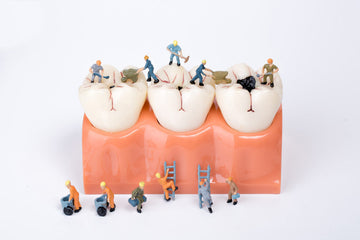How to Choose Veneers? A Full Guide to Materials and Styles

Thinking of improving your smile and achieving a perfect smile?
You are in luck because modern dentistry has the solution for you and it’s called: Veneers!
These thin, custom-made shells cover the front surface of your teeth to improve their appearance by altering their colour, shape, size, or length.
However, choosing the right veneers can be a challenge since plenty of options exist.
So, read along because you will find a full guide to materials and styles!
How to Choose Veneers?

The quick answer is depending on your dental needs and preferences.
However, since different types of materials, processes, and placement ways exist regarding veneers, you should first get to learn about them to make the right choice for your teeth.
Let’s see them one by one.
What Materials Are Used for Veneers?
There are three primary types of veneers regarding materials: plastic, porcelain (often also known as ceramic), and composite. Each type has its pros and cons thus understanding the differences is crucial.
1. Plastic Veneers

Plastic veneers are made from various kinds of plastics, acrylic being the strongest of them.
They are low-cost and used for mainly for fancy dress costumes. They come preformed and are removable/temporary veneers. In general, they are not recommended by dentists.
2. Ceramic Veneers

As their name implies, these types are made of a ceramic mixture that gives them ideal characteristics and are made in a dental lab.
These veneers are highly preferable due to their durability (they can last up to 15 years) and their aesthetically pleasing appearance that resembles natural enamel and is resistant to staining.
However, they are more expensive than plastic ones.
3. Composite Veneers

This type is a combination of both plastic and ceramic types, made of both materials and thus offering the best of two worlds.
Composite veneers thrive on durability and strength but are not as pleasing to the eye as ceramic ones.
Nevertheless, they are an affordable and quick solution since you can get them in just a visit to your dentist - they will sculpt the material on your teeth.
Do Different Procedures Exist for Applying Veneers?
Actually, yes.
Your dentist can choose amongst several ways the application process according to your needs. These can be:
· The Traditional Process: Your dentist will remove a layer of your tooth enamel and then cement a lab made ceramic veneer in place, similar to a false finger nail.
· The Temporary Process: These are made by the dentist and placed as a temporary while final ceramic veneers are being made in the lab.
· The Direct Process: Relates to making direct veneers which are sculpted by the dentist directly on to the teeth.
Are There Different Veneers’ Placement Options?
Not only one but three. You can choose between them:
· Window Veneers. This type covers the front side of your teeth but ends a bit before the biting part of the teeth.
· Incisal Veneers. This kind refers to the most common placement and covers the whole front of the teeth while going onto the biting and inside surface of the tooth.
· Palatal Veneers. This is the most integrated type since it’s designed to go on the backs of teeth. You may choose these veneers not for aesthetic purposes but for repairing badly damaged teeth and thus preserving your teeth’s structure.
What About Styles and Customisation of Veneers?
After deciding on the material and process, the next step is to consider the style of your veneers.
This involves selecting the colour, shape, and size that will best compliment your features. Let’s break them into pieces:
Colour
· Shade Matching: It’s important to choose a shade that closely matches your natural teeth or the desired whiteness. Don’t overdo it! You want your smile to be bright but also natural.
· Whiteness Level: Some patients prefer a dazzling white smile, while others go for a more subtle, natural shade. Reflect on how the outcome will blend with your overall complexion, the look you wish to achieve, and the reason you are doing it. Movie stars or TV personas have different needs from the rest of us.
Shape
· Tooth Shape: Veneers can be crafted in different shapes to match your aesthetic goals. For instance, rounded edges can provide a softer, more youthful look, while square shapes may appear more masculine or striking. Choose wisely.
· Uniformity: Depending on your preference, you can choose a uniform shape for all teeth or mix and match for a more natural, varied look.
Size
· Proportion: The size of the veneers should be proportionate to your facial features. Oversized veneers may look unnatural, while too-small veneers may damage your looks.
· Gum Line: The fit of the veneers against the gum line is also crucial. Well-fitted veneers will follow the natural contour of your gums, creating a seamless transition. Pay attention to that.
· Types of Teeth: Not all your teeth may need veneers. Consult your dentist whether you will cover your incisors, pre-molars, molars, or all of the above.
Which Type of Veneer is Best?
Finally, which type of veneer is best? The answer depends on your dental needs and your preferences.
Do you need a stunning smile? Do you wish to reshape your teeth a bit? How much money are you willing to invest in this aesthetic treatment?
For instance, if you long for a long-lasting outcome and a natural look choose porcelain veneers.
On the contrary, if you want a more affordable option that is considered decent go for composite. Whatever you choose there is a veneer style out there for you!
FAQs
1. What is The Most Popular Veneer Style?
The most popular veneer type is the ceramic or porcelain type.
Their durability, natural look, and stain-resistant characteristics make them score high in people’s preferences.
2. I Can’t Afford Porcelain Veneers. What Other Type Can I Choose?
If your budget can’t handle porcelain veneers, then the best choice for you is the composite ones.
You’ll get to have durability and a decent natural appearance in one package without spending too much.
3. Do Veneers Need Special Dental Care?
Make sure you don’t neglect your oral hygiene and follow these tips for lasting results:
- Visit Your Dentist for Regular Check-ups
- Refrain from Consuming Staining Agents (e.g. coffee, red wine, tobacco)
- Protect Your Teeth from Physical Damage (e.g. don’t bite on hard objects)
- Balance Bruxism (Teeth Grinding) (e.g. use a nightguard).
Choosing the (Right) Veneers For You
Having now this guide as your compass you can decide whether you will have plastic, porcelain, or composite veneers to brighten up your smile and fix your smile.
Choosing the right veneers involves a careful balance of aesthetics, durability, and personal preference, and it’s crucial to consult a specialised dentist to achieve the perfect result.
Feel free to contact an Enlighten Smiles dentist for guaranteed success.






